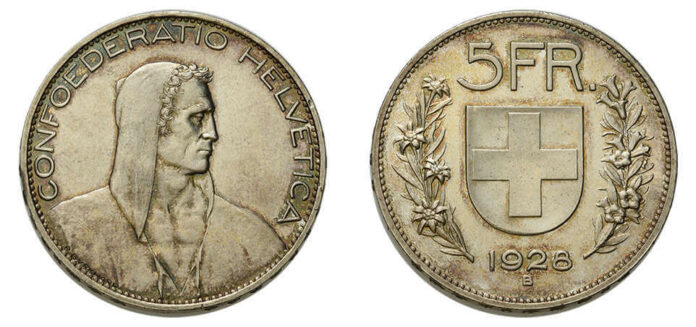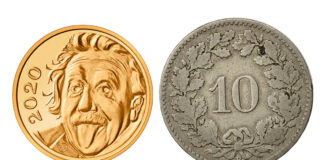On 6 May 2022, auction house Rapp in Wil will offer a small series of Swiss 5 franc pieces, which are affectionately called “Fünfliber” in Switzerland. The undisputed highlight of the 22 lots is a 5 franc piece from 1928 of a kind that only enters the market on extremely rare occasions. Moreover, the Rapp auction house refers to it as what is probably the best-preserved piece in private possession. In this article, we explain why the 5 franc piece of 1928 is even rarer than its mintage number of 23,971 specimens would suggest, and describe the historical developments that led to the fact that payments in Switzerland can now only be made with Swiss money.

The Latin Monetary Union and the First World War
In 1865, Switzerland was a founding member of the Latin Monetary Union (LMU). This means that coins from exactly defined states were allowed to circulate in Switzerland at the same value as their Swiss counterparts. In order to stabilise the currency, LMU members regularly agreed on minting quotas and the precious metal content of the coins.
This approach failed during the First World War, which resulted in high financial sacrifices for all warring parties. France, for instance, replaced its gold coins with 30,250 million francs in the form of banknotes, while “only” 733 million francs circulated in neutral Switzerland in the form of paper money at the same time. After the war, France hoped to restore its currency by means of the high reparation payments that the Treaty of Versailles imposed on Germany. After all, France was entitled to 52% of the 20 billion gold marks – more than 7,000 tons of gold at the time. This enormous sum was increased again at the London Conference of 1921 – to 226 billion gold marks – an amount that even the most vehement threats could not squeeze out of exhausted Germany.

A New Order for the Latin Monetary Union
Nevertheless, the reparations paid were enough for monetary relations to go back to normal. Gold coins re-entered the payment system. But then the next problem arose. After all, the currency of the Latin Monetary Union was based on a gold and silver standard.
Due to the short-term decline in the price of silver – it was only to rise again in the 1920s –silver coins of the LMU were overvalued. Switzerland had an export surplus, which led to foreign silver coins flooding Switzerland to such an extent that the National Bank was concerned. Only 4.8% of all 5 franc pieces that circulated in Switzerland had actually been produced in Switzerland. Foreign 5 franc coins worth 232 million Swiss francs were stored in Swiss coffers. How should they be banned from circulation? And how quickly could they be replaced by national money?
Swiss policymakers decided to go step by step. In March 1920, they arranged for France to buy back all French coins of denominations up to 2 francs that circulated in Switzerland – a total amount of CHF 43.38 million. Switzerland’s mint produced coins to replace them.
On 4 October 1920, Switzerland – without(!) consulting the other members of the LMU – banned the import of foreign 5 franc pieces and withdrew them from circulation on 28 December 1920. For the first time ever, all silver money in circulation in Switzerland was nationalised! It was not until one year later, on 9 December 1921, that the other members of the LMU accepted this shift in monetary policy.
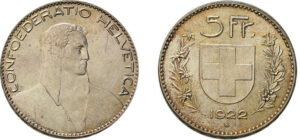
The New 5 Franc Piece
The last 5 franc issue of Switzerland bore the date 1916. The obverse depicted the head of Helvetia – a motif that was rather replaceable. Around the world, a woman’s head on the obverse had become “the” motif for democracies. But Swiss politicians wanted something new, something distinctive. After all, Swiss citizens should be able to notice when someone tried to give them a foreign coin.
As early as in 1919, a first competition had been announced to find a new, typically Swiss coin design. Without result. But the artists that submitted the best designs were invited to participate in a new competition. In the end, a decision of the Federal Council determined that the bust of the alpine shepherd by Paul Burkhard was to be the motif of future five franc pieces.
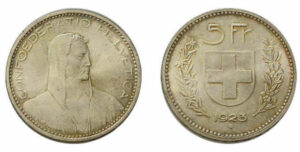
The first coin dies were not available until the end of 1923. Bearing the year 1922! But since the production of the coins could not be delayed any further – after all, foreign 5 franc pieces were not allowed to circulate anymore at the time – the new 5 franc pieces were minted with these unsatisfactory dies, 2.4 million specimens to be precise. At the same time, the master die was sent to Germany to be adjusted. But there, too, it was not possible to implement the design adequately. Despite the high minting pressure, the relief of the coins was simply not precise enough. When looking at the pieces, you cannot tell where the alpine shepherd’s neck ends and his hood begins. But the economy needed 5 franc pieces. Therefore, 11.3 million specimens were produced with these poor dies – however, many of the pieces were withdrawn from circulation once the problem had been solved adequately.
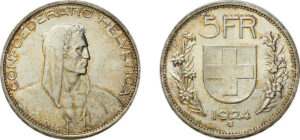
To achieve this, Paul Burkhard created another model of his motif, which was sent to England this time to implement the reduction. The master die was then sent to Berlin, where an engraver adjusted it once again. And, finally, they had a master die whose dies produced exactly the relief they had envisioned from the very beginning.
By the way, to give you an idea of the value of such a specimen: the minting costs alone were 0.3 rappens per coin. In addition, there were material costs amounting to 4.96 francs. Thus, the cost of materials accounted for the lion’s share of the coin, even if it was made from worn Swiss silver money and foreign 5 franc pieces that had been withdrawn from circulation.
Incidentally, the net hourly wage of an average male worker in 1928 was 87 rappens. Thus, a five franc piece was the equivalent of about six hours of hard labour. Women had to work even longer for it: more than eleven hours!
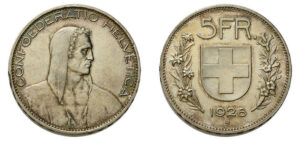
Why Only a Few 1928 5 Franc Pieces Survived
In the December of 1925, the Belgian government informed the French government that they decided to leave the Latin Monetary Union on 1 January 1927. They did not see another option of getting their fiscal difficulties under control. Shortly before the date, the Swiss Federal Council announced that it considered the Latin Monetary Union to be dissolved due to Belgium’s withdrawal.
No, there was no outcry. Neither abroad nor at home. Everyone was quite indifferent to the end of a monetary union that had linked important countries for more than half a century. After all, only a tiny thing changed for citizens: as of 8 February 1927, foreign gold coins were also banned from circulation in Switzerland.
For Swiss monetary policy, on the other hand, this was a paradigm shift. At last, Switzerland was able to determine how its coins should be made. The change to an all-gold standard made it possible to issue silver 5 franc coins at a very low weight.
The representatives of all major business associations voted in the so-called Five Francs Parliament (Fünfliberparlament) for a smaller and thus significantly lighter 5 franc piece that would still be made of silver. An expert commission, which met on 21 and 22 January 1929, confirmed the decision. Moreover, it abolished the 5 franc banknote, mainly at the request of the Swiss National Bank. It was too expensive: after all, such banknotes could only be used for two to three years but the production of a single banknote cost 6 rappens.
Although the law for the production of the new 5 franc pieces was only adopted on 9 September 1931, it was clear by the summer of 1928 that the new 5 franc pieces would be made of much less silver. And since silver accounted for the lion’s share of the minting costs, it would have been uneconomical to put the 23,971 specimens dated 1928 into circulation as the majority of them were probably still stored at the National Bank. From the vaults of the National Bank, they were directly sent to the mint to be melted down and turned into new, smaller 5 franc coins.
And that’s why the 5 franc piece from 1928 is much rarer on the collector market than you would expect given its mintage number of 23,971 specimens.
Read the extensive preview of the Rapp Auction on May 6, 2022.
For more information about Rapp Auction House, visit the website of Rapp.
Read more about the Latin Monetary Union and the European monetary policy of that time.
Here you can find out, which are the most precious coins of Switzerland.



